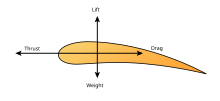



Influid mechanics, an aerodynamic force is a force exerted on a body by the air (or other gas) in which the body is immersed, and is due to the relative motion between the body and the gas.
There are two causes of aerodynamic force: [1]: §4.10 [2][3]: 29
Pressure acts normal to the surface, and shear force acts parallel to the surface. Both forces act locally. The net aerodynamic force on the body is equal to the pressure and shear forces integrated over the body's total exposed area.[4]
When an airfoil moves relative to the air, it generates an aerodynamic force determined by the velocity of relative motion, and the angle of attack. This aerodynamic force is commonly resolved into two components, both acting through the center of pressure:[3]: 14 [1]: § 5.3
In addition to these two forces, the body may experience an aerodynamic moment.
The force created by propellers and jet engines is called thrust, and is also an aerodynamic force (since it acts on the surrounding air). The aerodynamic force on a powered airplane is commonly represented by three vectors: thrust, lift and drag.[3]: 151 [1]: § 14.2
The other force acting on an aircraft during flight is its weight, which is a body force and not an aerodynamic force.